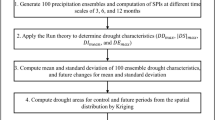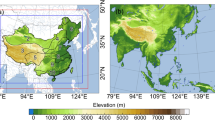Abstract
Assessment of future drought characteristics based on climate models is difficult as climate models usually have bias in simulating precipitation frequency and intensity. In this study, we examine the significance of bias correction in the context of drought frequency and scenario analysis using output from climate models. In particular, we use three bias correction techniques with different emphases and complexities to investigate how they affect the results of drought frequency and severity based on climate models. The characteristics of drought are investigated using regional climate model (RCM) output from the North American Regional Climate Change Assessment Program (NARCCAP). The Standardized Precipitation Index (SPI) is used to compare and forecast drought characteristics at different timescales. Systematic biases in the RCM precipitation output are corrected against the National Centers for Environmental Prediction (NCEP) North American Regional Reanalysis (NARR) data and the bias-corrected RCM historical simulations. Preserving mean and standard deviation of NARR precipitation is essential in drought frequency analysis. The results demonstrate that bias correction significantly decreases the RCM errors in reproducing drought frequency derived from the NARR data. Different timescales of input precipitation in the bias corrections show similar results. The relative changes in drought frequency in future scenario compared to historical scenario are similar whether both scenarios are bias corrected or both are not bias corrected.



Similar content being viewed by others
References
Addor N, Rohrer M, Furrer R, Seibert J (2016) Propagation of biases in climate models from the synoptic to the regional scale: implications for bias adjustment. J Geophys Res: Atmospheres 121(5):2075–2089. doi:10.1002/2015JD024040
Chen J, Brissette FP, Lucas-Picher P (2015) Assessing the limits of bias-correcting climate model outputs for climate change impact studies. J Geophys Res: Atmospheres 120:1123–1136. doi:10.1002/2014JD022635
Diaz HF (1983) Drought in the United States. J Clim Appl Meteorol 22(1):3–16
Edwards TB, McKee DC (1997) Characteristics of 20th century drought in the United States at multiple time scales. (No. AFIT-97-051). AIR FORCE INST OF TECH WRIGHT-PATTERSON AFB OH. Climatological Report No. 97–2
Ehret U, Zehe E, Wulfmeyer V, Warrach-Sagi K, Liebert J (2012) HESS Opinions “Should we apply bias correction to global and regional climate model data?”. Hydrol Earth Syst Sci 16(9):3391–3404. doi:10.5194/hess-16-3391-2012
Guttman NB (1999) Accepting the standardized precipitation index: a calculation algorithm. J Am Water Resour Assoc 35:311–322
Jeong DI, Sushama L, Khaliq MN (2014) The role of temperature in drought projections over North America. Clim Chang 127(2):298–303. doi:10.1007/s10584-014-1248-3
Johnson F, Sharma A (2011) Accounting for interannual variability: a comparison of options for water resources climate change assessments. Water Resourc Res 47, W04508. doi:10.1029/2010WR009272
Johnson F, Sharma A (2015) What are the impacts of bias correction on future drought projections? J Hydrol 525:472–485
Karl TR, Koscielny AJ (1982) Drought in the United States: 1895–1981. J Climatol 2(4):313–329
Karl TR, Koss WJ (1984) Regional and national monthly, seasonal, and annual temperature weighted by area. U.S. Department of Commerce. National Climate Data Center, Asheville
Li H, Sheffield J, Wood EF (2010) Bias correction of monthly precipitation and temperature field from Intergovernmental Panel on Climate Change AR4 models using equidistance quantile matching. J Geophys Res 115, D10101. doi:10.1029/2009JD012882
Maraun D, Wetterhall, Thiele-Eich I (2010) Precipitation downscaling under climate change: recent developments to bridge the gap between dynamical models and the end user. Rev Geophys 48(3):RG3003. doi:10.1029/2009RG000314
McKee TB, Doesken NJ, Lkeist J (1993) The relationship of drought frequency and duration to time scales. Eighth Conference on Applied Climatology. Anaheim, California
Mesinger F, Dimego G, Kalnay E, Mitchell K, Shafran PC, EbisuzakiW, … Shi W (2006) North American regional reanalysis. Bul Am Meterol Soc 87: 343–360. doi:10.1175/BAMS-87-3-343
Mishra AK, Singh VP (2010) A review of drought concept. J Hydrol 391:202–216. doi:10.1016/J.jhydrol.2010.07.012
Natle HK, Gan TY (2003) Drought indices and their application to east Africa. Int J Climatol 23(11):1335–1357. doi:10.1002/joc.931
Nguyen H, Mehrotra R, Sharma A (2016) Correcting for systematic biases in GCM simulations in the frequency domain. J Hydrol 538:117–126. doi:10.1016/j.jhydrol.2016.04.018
Osuch M, Romanowicz RJ, Lawrence D, Wong WK (2015) Assessment of the influence of bias correction on meteorological drought projections for Poland. Hydrol Earth Syst Sci Discuss 12:10331–10377. doi:10.5194/hessd-12-10331-2015
Rosenberg EA, Keys PW, Booth DB, Hartley D, Burkey J, Steinemann AC, Lettenmaier DP (2010) Precipitation extremes and the impacts of climate change on stormwater infrastructure in Washington State. Clim Chang 102(1–2):319–349. doi:10.1007/s10584-010-9847-0
Sheffield J, Wood EF (2008) Projected changes in drought occurrence under global warming from multi-model, multi-scenario, IPCC AR4 simulations. Clim Dyn 31(1):79–105. doi:10.1007/s00382-007-0340-z
Teutschbein C, Seibert J (2012) Bias correction of regional climate model simulations for hydrological climate-change impact studies: review and evaluation of different methods. J Hydrol 456:12–29. doi:10.1016/j.jhydrol.2012.05.052
Teutschbein C, Seibert J (2013) Is bias correction of regional climate model (RCM) simulations possible for non-stationary conditions? Hydrol Earth Syst Sci 17(12):5061–5077. doi:10.5194/hess-17-5061-2013
Thom H (1966) Some methods of climatological analysis. Secretariat of the World Meteorological Organization
Vicente-Serrano S, Beguera S, Lopez-Moreno J (2010) A multiscalar drought index sensitive to global warming: the standardized precipitation evapotranspiration index. J Clim 23:1696–1718. doi:10.1175/2009JCLI2909.1
Wehner M, Santer B (2011) Projections of future drought in the Continental United States and Mexico. J Hydrometeorol 12(6):1359–1377. doi:10.1175/2011JHM1351.1
Wood AW, Maurer EP, Kumar A, Lettenmaier DP (2002) Long-range experimental hydrologic forecasting for the eastern United States. J Geophys Res 107. doi:10.1029/2001JD000659
Wood A, Leung LR, Lettenmaier DP (2004) Hydrological implications of dynamical and statistical approaches to downscaling climate model outputs. Climate Change 62:189–216
World Meteorological Organization (2012) Standardized Precipitation Index User Guide. Geneva, Switzerland
Xu C-Y (1999) Climate change and hydrologic models: a review of existing gaps and recent research developments. Water Resour Manag 13:369–382
Xu C-Y, Singh V (2004) Review on regional water resources assessment models under stationary and changing climate. Water Resour Manag 18:591–612
Zarch MAA, Sivakumar B, Sharma A (2015) Droughts in a warming climate: a global assessment of Standardised precipitation index (SPI) and Reconnaissance drought index (RDI). J Hydrol 526:183–195. doi:10.1016/j.jhydrol.2014.09.071
Zhu J (2013) Impact of climate change on extreme rainfall across the United States. J Hydrol Eng 18(10):1301–1309. doi:10.1061/(ASCE)HE.1943-5584.0000725
Zhu J, Forsee W, Schumer R, Gautam MR (2013) Future projections and uncertainty assessment of extreme rainfall intensity in the United States from an ensemble of climate models. Clim Chang 118(2):469–485. doi:10.1007/s10584-012-0639-6
Author information
Authors and Affiliations
Corresponding author
Electronic supplementary material
Below is the link to the electronic supplementary material.
ESM 1
(DOCX 54 kb)
Rights and permissions
About this article
Cite this article
Aryal, Y., Zhu, J. On bias correction in drought frequency analysis based on climate models. Climatic Change 140, 361–374 (2017). https://doi.org/10.1007/s10584-016-1862-3
Received:
Accepted:
Published:
Issue Date:
DOI: https://doi.org/10.1007/s10584-016-1862-3




